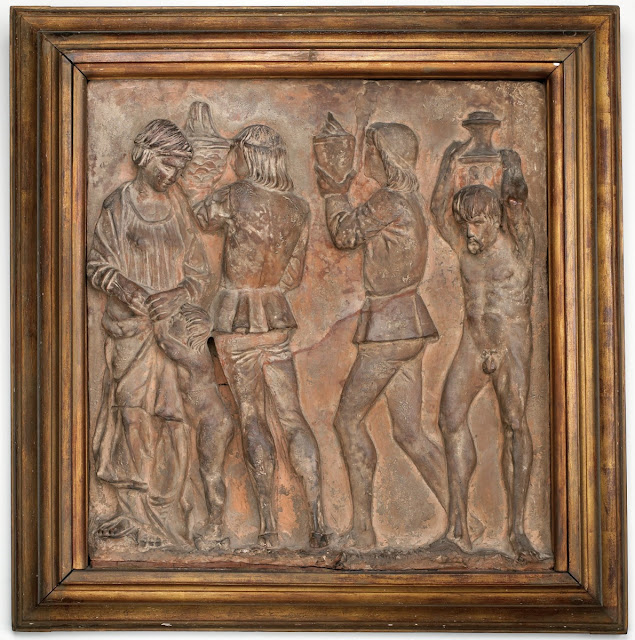 |
| Archaic Greece Pinax with Sphinx and Griffin (fragment) ca. 600-570 BC terracotta relief Harvard Art Museums |
 |
| Greek culture in South Italy Sphinx seated on Aeolic Capital ca. 480-460 BC terracotta relief Museum of Fine Arts, Boston |
 |
| Greek culture in South Italy Herakles Reclining ca. 200-100 BC terracotta relief Museum of Fine Arts, Boston |
"The use of clay amongst the Greeks was varied and extensive. Among the manifold purposes to which terracotta was put may be mentioned parts of public and private buildings, such as bricks, roof tiles, drains and flue tiles, and architectural ornaments; tombs and coffins; statues and statuettes, for votive or sepulchral purposes or for the decoration of houses; imitations of metal vases and jewelry; and such everyday objects as spindle whorls, theatre tickets, lamps, braziers and domestic utensils. It also supplied the potter with moulds and the sculptor with models for works of art, especially in bronze."
– Encyclopedia Britannica (11th edition, 1911)
 |
| Donatello Madonna and Child ca. 1455-60 gilded terracotta relief Victoria & Albert Museum |
 |
| attributed to Domenico di Paris Madonna and Child ca. 1470 painted terracotta relief Museum of Fine Arts, Boston |
 |
| attributed to Luca della Robbia Madonna and Child with Lilies ca. 1460-70 glazed terracotta relief Museum of Fine Arts, Boston |
" . . . the field of replicated relief sculpture was transformed by Luca della Robbia's development of shiny opacified tin-based enamel glazes that could be fired onto clay sculpture to create surfaces decorated with light-reflecting, long lasting, and intense colours unlike anything produced by ordinary paints. The hard glazes were durable and even helped to preserve the underlying terracotta, whereas paint tended to flake off over time, exposing the vulnerable moulded forms to damage. Luca's invention combined the best of painting and sculpture: he usually glazed his Madonna and Child in white to suggest that they were made of the much more expensive and heavy material of marble. The accents of colour around their eyes enlivened their gazes even as their pale bodies became ethereal, when viewed in flickering candlelight. The figures were set off by iconographic accessories, surrounding backgrounds and frames in a variety of rich, luminous colours. For all these reasons, Luca's glazed terracotta sculptures became the preferred choice of buyers who could afford them. By mid-century the former marble sculptor devoted himself and his workshop almost exclusively to their production, a specialisation that his nephew Andrea and great-nephew Giovanni continued well into the sixteenth century."
– Donal Cooper, from Depth of Field: Relief Sculpture in Renaissance Italy (Peter Lang, 2007)
 |
| Andrea della Robbia Prudence ca. 1475 glazed terracotta relief Metropolitan Museum of Art, New York |
 |
| Anonymous Italian sculptor Copy of figures from a 15th-century Frieze in Palazzo Fodri, Cremona (Nude Warriors with Horses) 19th century terracotta relief National Gallery of Canada |
 |
| Gianlorenzo Bernini Sketch for Allegorical Figure 1630-31 terracotta relief Harvard Art Museums |
"Modeling in clay is to the sculptor what drawing on paper is to the painter. For as the first pressing of the juice of the grape forms the finest wine, so in the soft clay and on paper the genius of the artist is seen in the utmost purity and truth; while, on the contrary, talent is concealed beneath the industry and the polish required in a completed statue or a finished painting. . . . This attention to sculpture in clay is confirmed by contemporary experience, and one can state as a general rule that nothing bad of this kind is ever found, an assertion that cannot be made of reliefs in marble."
– J.J. Winckelmann, from History of Ancient Art (1763)
 |
| Alessandro Algardi Pope Liberius baptizing the Neophytes 1647-49 terracotta relief (modello for a marble panel) Minneapolis Institute of Art |
 |
| Melchiorre Cafà Partial Model for the Martyrdom of St Eustace (Church of Sant' Agnese in Piazza Navona, Rome) ca. 1660 terracotta relief Los Angeles County Museum of Art |
 |
| attributed to Melchiorre Cafà David dancing before the Ark ca. 1660-65 terracotta relief (modello for a bronze plaque) Victoria & Albert Museum |
 |
| John Flaxman Self-portrait 1778 terracotta relief Victoria & Albert Museum |
